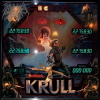Hacker (Commodore 64) review"To understand why Hacker became a cult classic, first it's necessary to know that the actual game is only part of the package. Think back to 1985, when games were already sold in stores, in a way not all that different from today - flashy boxes with cover art, blurbs of advertizing and little screenshots on the back, and a new smelling game and paper manual inside. Hacker, in the meantime, has a non-descript box with very little information on it, and inside, only a Commodore 64 cassette tape. N..." |
To understand why Hacker became a cult classic, first it's necessary to know that the actual game is only part of the package. Think back to 1985, when games were already sold in stores, in a way not all that different from today - flashy boxes with cover art, blurbs of advertizing and little screenshots on the back, and a new smelling game and paper manual inside. Hacker, in the meantime, has a non-descript box with very little information on it, and inside, only a Commodore 64 cassette tape. No manual. Only a game tempting you to load it up.
Once you do, a blue screen appears with only the words "Logon please". You shrug and type something at random, only to have your logon rejected. You try a few more times until the system helpfully offers you "H for help", at which point it'll tell you that the current password is the location of the test site. What test site? Your next logon is rejected too and the system is about to disconnect you when suddenly error messages appear, and you somehow make it inside anyway.
Next, schematics for some sort of robot called an SRU appear, and you are prompted to point out specific parts as they are named, as part of a diagnosis test. Still having no idea what you're doing or where the parts in question are, you highlight random parts of the robot until they are accepted as the right ones. The diagnostic ends, but the system is unsatisfied that you didn't get them all right at once, and prompts you to start over.
By the time you get through it flawlessly on memory, and you've been playing for some 20 or 30 minutes, you'll have started wondering what the point of the game is. It keeps you guessing a while longer. The bottom part of the screen now displays a map of the world, the top part a first person view of a tunnel, and the parting words "your Subterranean Reconnaissance Unit is stationed in the South Atlantic". An indicator lights up "MSG" and an alarm starts blaring, which eventually gives way to an inbound message once you figure out you're supposed to press M.
It is only at that point that you finally get some explanation, but not much. You are connected through your computer to a robotic vehicle in an underground - or in this case, underseas - tunnel. The robot belongs to Magma, Ltd, the company whose computers you logged into at the start. As you start moving the robot around the tunnels using the joystick, another message pops up which finally gives you your objective. A vital document belonging to Magma has been stolen and split up into ten pieces, now in the hands of spies all over the globe. Your mission is to seek them out and bribe them into returning the pieces, either by cash offer or by buying various kinds of merchandise off them that can then be offered to other spies. You are warned to do this before "the federals" can get their hands on the document, and to "stay clear of the test site" as there is a risk of "continental destruction". Welcome to Hacker.
I'm describing all this because 90% of the Hacker experience is the mystique. You start out not knowing what kind of game you just bought - marketing, I imagine, was mostly word of mouth - and even as you play and even lose your first sessions, you still barely know what you're doing. Getting used to moving around the tunnels is easy enough, and eventually you'll find your way to various cities marked on the map, where you can then meet with one of the spies and piece together the document. Each spy, when given the right item (or in the case of the first, a generous cash bribe), will offer up his piece and also offer two more items for sale, which you may or may not need to give to another spy. You can't afford them all, though, and it's even possible that a spy will accept several different items, including some that are the only item a different spy will accept. Furthermore, the tunnels are a bit of a maze, and it's impossible to tell except by experimentation how to get from one city to another. To make matters worse, parts of your robot begin failing as the game proceeds, first making it harder to navigate and then making your position invisible entirely, requiring you to work entirely on memory or (more likely) a map you're drawing as you go.
Many playthroughs will be needed to establish the right way to get through the game. Mapmaking, experimenting with offering items to spies, determining the shortest route between all the cities you need to visit (you're working on a time limit before you get disconnected, too), and also piecing together the story and your ultimate objective (let's just say the game's title has significance). The excitement of figuring this all out bit by bit is precisely what made Hacker work. It had to, because the gameplay is very simple, challenging only because nothing less than a perfect game will work. Trade one item away to the wrong spy, buy one item you don't need and that will leave you with too little money later on, or even take one wrong turn anywhere in the tunnels so you can no longer complete your mission within the time limit, and your game is once again doomed to failure. This kind of punishing difficulty is not uncommon for its era, but the game consists of nothing else than moving around and trading items. It would be hard to stay motivated long enough to pull it off, but for the air of mystery surrounding the story. Everything including the introductory scenes and the way the game itself was packaged and sold banks on this. In an age where looking up the right solution online after two failed attempts is all too tempting, something like this might never work again.
Is Hacker something you need to play now, after all that time? Doubtful. By today's standards, the game demands an unreasonable amount of patience for practically no return value. With a FAQ in hand it can be played through in 15 minutes (the complete solution can be summed up in about 200 words), but then nothing of what made this a cult classic in the first place works at all. But you've got to admire how successful Hacker was at the time just for doing things so differently, and that's what my grade is based on.
 |  |  |  |  |
Community review by sashanan (September 14, 2008)
Sashanan doesn't drink coffee; he takes tea, my dear. And sometimes writes reviews. His roots lie with the Commodore 64 he grew up with, and his gaming remains fragmented among the very old, the somewhat old, and rarely the new. |
|
More Reviews by sashanan [+]
|
|
If you enjoyed this Hacker review, you're encouraged to discuss it with the author and with other members of the site's community. If you don't already have an HonestGamers account, you can sign up for one in a snap. Thank you for reading!
User Help | Contact | Ethics | Sponsor Guide | Links












